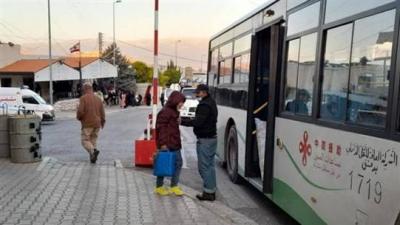From the 12 displaced individuals who crossed the Al-Masnaa border gate last week in the first voluntary return trip to Syria since the COVID-19 pandemic, the number decreased in the second return convoy that took place last Saturday through the same gate. Only ten displaced persons left, after four individuals who had registered their names missed the meeting time set at 6 AM at the Al-Masnaa point, and thus missed the bus registered under the "General Company for Internal Transport in Damascus," which was waiting for them on the Lebanese side of the border. This was part of the logistical arrangements overseen by Syrian authorities for citizens wishing to return. The bus left Lebanese territory within minutes, thanks to the facilities provided by the Lebanese General Security.
The returnees arrived early at the Al-Masnaa point, and it turned out that they also did not come from any of the camps in Baalbek, which host the largest gatherings of displaced persons, but rather from the Hasbaya area, noting that the displaced individuals who returned in the first convoy were from Nabatieh. Some of those in the second return bus were supposed to be in the first convoy, but the delay in obtaining approval from Syrian authorities for their situation caused them to wait for the following week.
Thus, the total number of displaced persons who left Lebanon through the main border gate at Al-Masnaa stands at 22. This number is not significant when compared to the thousands of displaced individuals who crossed this main border into Lebanon from March 2011 until 2015, when the General Directorate of General Security decided to regulate the entry of Syrians into Lebanon and their residency there, following another decision in June 2014 that stripped the refugee status from any Syrian who frequently returned to their country. This directly meant that they would not benefit from the assistance and services provided by the UN High Commissioner for Refugees and donor organizations for displaced persons.
Consequently, the role of this official crossing into Lebanon has declined in terms of receiving or bidding farewell to displaced persons. However, this does not hinder the movement of Syrians residing in Lebanon as displaced individuals to their homeland. Many of them have no concerns about voluntarily entering Syria; however, their main concern is that their departure will be recorded by Lebanese General Security, as this would lead to the loss of available assistance due to their refugee status.
This timid return has not changed the daily observations of the number of people using the rugged mountain roads, opting for smuggling routes into and out of Syria. Security sources in the Al-Masnaa border area confirm the ongoing phenomenon of human smuggling across the borders, asserting that the main reason for this is evasion of the implications of the 2014 decision, which is still being applied at legitimate borders today, especially to ensure continued benefit from the assistance of donor organizations for displaced persons in Lebanon.
Those following the issue do not expect these individuals to regularize their legal status with Lebanese and Syrian authorities to facilitate their return to their country, as long as humanitarian aid for Syrian displaced persons in their areas of displacement continues. Thus, the role of the Al-Masnaa border center concerning the return issue will remain secondary, even lagging behind the role currently played by the mountain crossing from the Wadi Hamid area in Arsal toward the Jarajir region on the Syrian border, where a larger number of returnees was recorded last Saturday, despite the modest figures for returnees in comparison to the numbers of displaced persons residing in Arsal.
Nevertheless, some individuals wishing to leave permanently remain in a state of anticipation regarding the fate of those returning in the first convoys, especially after rumors circulated about the detention of three of them last week, which Minister of Social Affairs Hector Hajjar did not deny during his follow-up on the second return convoy. He clarified that these individuals left outside the organized and coordinated return campaign with Syrian authorities and consequently advised those wishing to return at their own risk to use Lebanon's legitimate crossings, including the Al-Masnaa crossing.




